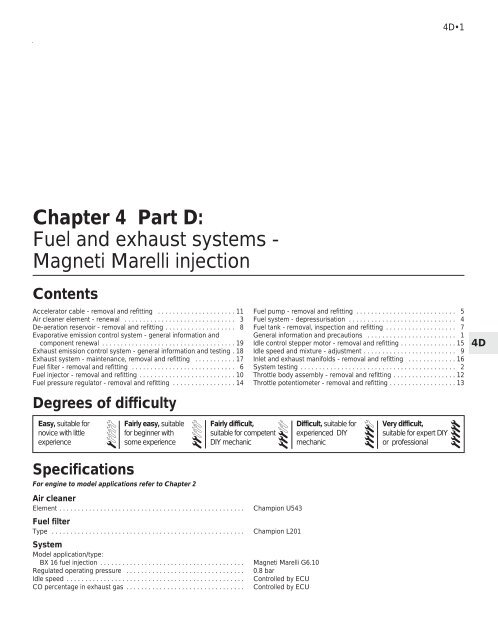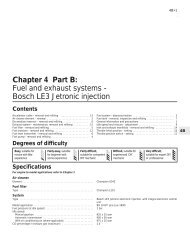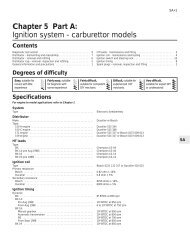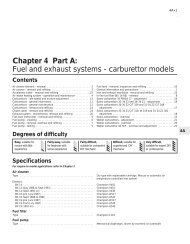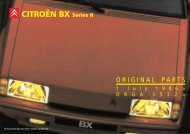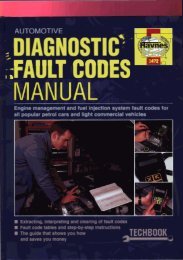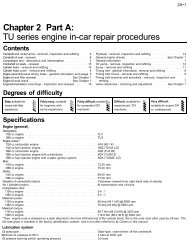Chapter 4 Part D: Fuel and exhaust systems - Magneti Marelli injection
Chapter 4 Part D: Fuel and exhaust systems - Magneti Marelli injection
Chapter 4 Part D: Fuel and exhaust systems - Magneti Marelli injection
You also want an ePaper? Increase the reach of your titles
YUMPU automatically turns print PDFs into web optimized ePapers that Google loves.
4D•1<br />
<strong>Chapter</strong> 4 <strong>Part</strong> D:<br />
<strong>Fuel</strong> <strong>and</strong> <strong>exhaust</strong> <strong>systems</strong> -<br />
<strong>Magneti</strong> <strong>Marelli</strong> <strong>injection</strong><br />
Contents<br />
Accelerator cable - removal <strong>and</strong> refitting . . . . . . . . . . . . . . . . . . . . . 11<br />
Air cleaner element - renewal . . . . . . . . . . . . . . . . . . . . . . . . . . . . . . 3<br />
De-aeration reservoir - removal <strong>and</strong> refitting . . . . . . . . . . . . . . . . . . . 8<br />
Evaporative emission control system - general information <strong>and</strong><br />
component renewal . . . . . . . . . . . . . . . . . . . . . . . . . . . . . . . . . . . . 19<br />
Exhaust emission control system - general information <strong>and</strong> testing . 18<br />
Exhaust system - maintenance, removal <strong>and</strong> refitting . . . . . . . . . . . 17<br />
<strong>Fuel</strong> filter - removal <strong>and</strong> refitting . . . . . . . . . . . . . . . . . . . . . . . . . . . . 6<br />
<strong>Fuel</strong> injector - removal <strong>and</strong> refitting . . . . . . . . . . . . . . . . . . . . . . . . . . 10<br />
<strong>Fuel</strong> pressure regulator - removal <strong>and</strong> refitting . . . . . . . . . . . . . . . . . 14<br />
Degrees of difficulty<br />
Easy, suitable for<br />
novice with little<br />
experience<br />
1<br />
Fairly easy, suitable<br />
for beginner with<br />
some experience<br />
2<br />
Fairly difficult,<br />
suitable for competent<br />
DIY mechanic<br />
<strong>Fuel</strong> pump - removal <strong>and</strong> refitting . . . . . . . . . . . . . . . . . . . . . . . . . . . 5<br />
<strong>Fuel</strong> system - depressurisation . . . . . . . . . . . . . . . . . . . . . . . . . . . . . 4<br />
<strong>Fuel</strong> tank - removal, inspection <strong>and</strong> refitting . . . . . . . . . . . . . . . . . . . 7<br />
General information <strong>and</strong> precautions . . . . . . . . . . . . . . . . . . . . . . . . 1<br />
Idle control stepper motor - removal <strong>and</strong> refitting . . . . . . . . . . . . . . . 15<br />
Idle speed <strong>and</strong> mixture - adjustment . . . . . . . . . . . . . . . . . . . . . . . . . 9<br />
Inlet <strong>and</strong> <strong>exhaust</strong> manifolds - removal <strong>and</strong> refitting . . . . . . . . . . . . . 16<br />
System testing . . . . . . . . . . . . . . . . . . . . . . . . . . . . . . . . . . . . . . . . . . 2<br />
Throttle body assembly - removal <strong>and</strong> refitting . . . . . . . . . . . . . . . . . 12<br />
Throttle potentiometer - removal <strong>and</strong> refitting . . . . . . . . . . . . . . . . . . 13<br />
3<br />
Difficult, suitable for<br />
experienced DIY<br />
mechanic<br />
4<br />
Very difficult,<br />
suitable for expert DIY<br />
or professional<br />
5<br />
4D<br />
Specifications<br />
For engine to model applications refer to <strong>Chapter</strong> 2<br />
Air cleaner<br />
Element . . . . . . . . . . . . . . . . . . . . . . . . . . . . . . . . . . . . . . . . . . . . . . . . . .<br />
<strong>Fuel</strong> filter<br />
Type . . . . . . . . . . . . . . . . . . . . . . . . . . . . . . . . . . . . . . . . . . . . . . . . . . . .<br />
Champion U543<br />
Champion L201<br />
System<br />
Model application/type:<br />
BX 16 fuel <strong>injection</strong> . . . . . . . . . . . . . . . . . . . . . . . . . . . . . . . . . . . . . . . <strong>Magneti</strong> <strong>Marelli</strong> G6.10<br />
Regulated operating pressure . . . . . . . . . . . . . . . . . . . . . . . . . . . . . . . . 0.8 bar<br />
Idle speed . . . . . . . . . . . . . . . . . . . . . . . . . . . . . . . . . . . . . . . . . . . . . . . . Controlled by ECU<br />
CO percentage in <strong>exhaust</strong> gas . . . . . . . . . . . . . . . . . . . . . . . . . . . . . . . . Controlled by ECU
4D•2 <strong>Fuel</strong> <strong>and</strong> <strong>exhaust</strong> <strong>systems</strong> - <strong>Magneti</strong> <strong>Marelli</strong> <strong>injection</strong><br />
1 General information <strong>and</strong><br />
precautions<br />
General information<br />
On fuel-injected BX 16 models, a<br />
fully-integrated <strong>Magneti</strong> <strong>Marelli</strong> G6.10 engine<br />
management system is used to control both<br />
the single-point fuel <strong>injection</strong> <strong>and</strong> ignition<br />
<strong>systems</strong>. This system also incorporates a<br />
closed-loop catalytic converter <strong>and</strong> an evaporative<br />
emission control system, complying to<br />
the very latest emission control st<strong>and</strong>ards.<br />
The system operates as follows.<br />
The fuel pump (mounted on the rear of the<br />
subframe) pumps fuel from the tank to injector<br />
via a filter. <strong>Fuel</strong> supply pressure is controlled<br />
by the pressure regulator in the throttle body<br />
assembly, which lifts to allow excess fuel to<br />
return to the tank when the optimum<br />
operating pressure of the system is exceeded.<br />
The electrical control system consists of the<br />
ECU, along with the following sensors (see<br />
illustration):<br />
a) Manifold absolute pressure (MAP) sensor<br />
- informs the ECU of engine load<br />
b) Crankshaft sensor - informs the ECU of<br />
crankshaft position <strong>and</strong> engine speed<br />
c) Throttle potentiometer - informs the ECU<br />
of throttle valve position <strong>and</strong> rate of<br />
throttle opening/closing<br />
d) Coolant temperature sensor - informs the<br />
ECU of engine temperature<br />
e) <strong>Fuel</strong>/air mixture temperature sensor -<br />
informs the ECU of temperature of fuel/air<br />
mixture charge entering cylinders<br />
f) Lambda (oxygen) sensor - informs the<br />
ECU of oxygen content of <strong>exhaust</strong> gases<br />
The ECU senses battery voltage, adjusting<br />
the injector pulse width to suit <strong>and</strong> using the<br />
stepper motor to increase the idle speed <strong>and</strong><br />
therefore, the alternator output if the voltage is<br />
too low. Short-circuit protection <strong>and</strong><br />
diagnostic capabilities are incorporated. The<br />
ECU can both receive <strong>and</strong> transmit information<br />
via the engine management circuit diagnostic<br />
connector, thus permitting engine diagnosis<br />
<strong>and</strong> tuning by special diagnostic equipment.<br />
All the above signals are compared by the<br />
ECU which then selects the appropriate<br />
response <strong>and</strong> controls the ignition HT coil<br />
(varying the ignition timing as required), <strong>and</strong> the<br />
fuel injector (varying its pulse width the length<br />
of time the injector is held open - to provide a<br />
richer or weaker mixture, as appropriate). The<br />
mixture, idle speed <strong>and</strong> ignition timing are<br />
constantly varied by the ECU to provide the<br />
best settings for cranking, starting <strong>and</strong> engine<br />
warm-up, idle, cruising <strong>and</strong> acceleration.<br />
1 Throttle body injector housing<br />
2 Idle speed stepper motor<br />
3 Charcoal canister purge valve<br />
4 Throttle potentiometer<br />
5 ECU<br />
1.3 <strong>Magneti</strong> <strong>Marelli</strong> engine management system<br />
components<br />
6 Instrument panel warning light<br />
7 Diagnostic wiring connector<br />
8 Relay unit<br />
9 Manifold absolute pressure (MAP)<br />
sensor<br />
10 Ignition HT coil<br />
11 Crankshaft sensor<br />
12 <strong>Fuel</strong>/air mixture temperature sensor<br />
13 Coolant temperature sensor<br />
14 Lambda (oxygen) sensor
<strong>Fuel</strong> <strong>and</strong> <strong>exhaust</strong> <strong>systems</strong> - <strong>Magneti</strong> <strong>Marelli</strong> <strong>injection</strong> 4D•3<br />
2.3 System diagnostic connector 5.1 <strong>Fuel</strong> pump <strong>and</strong> filter (plastic cover unclipped for clarity)<br />
The ECU also regulates the engine idle<br />
speed via a stepper motor which is fitted to the<br />
throttle body. The motor has a pushrod which<br />
controls the opening of an air passage which<br />
bypasses the throttle valve. When the throttle<br />
valve is closed, the ECU controls the movement<br />
of the pushrod, which in turn regulates<br />
the amount of air which flows through the<br />
throttle body, so controlling the idle speed.<br />
The bypass passage is also used as an<br />
additional air supply during cold starting.<br />
There is no provision for adjustment of the idle<br />
speed, except by reprogramming of the ECU<br />
using special diagnostic equipment. The idle<br />
speed will vary constantly under ECU control.<br />
The ECU controls the ignition side of the<br />
engine management system (see <strong>Chapter</strong> 5)<br />
<strong>and</strong> the <strong>exhaust</strong> <strong>and</strong> evaporative emission<br />
control <strong>systems</strong> described later in this<br />
<strong>Chapter</strong>.<br />
If there is an abnormality in any of the<br />
readings obtained from any of engine<br />
management circuit sensors, the ECU has a<br />
back-up facility. It ignores any abnormal<br />
sensor signals <strong>and</strong> assumes a pre-programmed<br />
value which will allow the engine to<br />
continue running at reduced efficiency. On<br />
entering the back-up facility, the ECU will<br />
illuminate the engine management warning<br />
light in the instrument panel, thereby<br />
informing the driver of the fault. It then stores<br />
the relevant fault code in the ECU memory. If<br />
the warning light is illuminated, the vehicle<br />
should be taken to a Citroën dealer for system<br />
testing at the earliest opportunity.<br />
Precautions<br />
Refer to the precautions listed in <strong>Part</strong> C of<br />
this <strong>Chapter</strong>, noting the following:<br />
Unleaded petrol - usage<br />
As with all models equipped with a catalytic<br />
converter, these models must be run on 95<br />
RON unleaded fuel only. The use of leaded<br />
fuel will seriously damage the catalytic<br />
converter.<br />
2 System testing<br />
5<br />
Note: Ensure that all wiring connectors are secure<br />
<strong>and</strong> free of corrosion before checking for<br />
faults in the engine management system.<br />
1 If a fault appears in the engine management<br />
(ignition/fuel <strong>injection</strong>) system, first ensure<br />
that all the system wiring connectors are securely<br />
connected <strong>and</strong> free of corrosion.<br />
2 Ensure that any fault is not due to poor<br />
maintenance. That is, check that the air<br />
cleaner element is clean, the spark plugs are<br />
in good condition <strong>and</strong> correctly gapped, that<br />
the valve clearances are correctly adjusted<br />
<strong>and</strong> that the engine breather hoses are clear<br />
<strong>and</strong> undamaged.<br />
3 If these checks fail to reveal the cause of<br />
the problem, the vehicle should be taken to a<br />
Citroën dealer for testing. A wiring block<br />
connector is incorporated in the engine<br />
management circuit, into which a special<br />
electronic diagnostic tester can be plugged<br />
(see illustration). The tester will locate the<br />
fault quickly <strong>and</strong> simply, alleviating the need<br />
to test all the system components individually,<br />
which is a time-consuming operation that<br />
carries a high risk of damaging the ECU.<br />
3 Air cleaner element - renewal<br />
Refer to <strong>Chapter</strong> 1, Section 28.<br />
1<br />
4 <strong>Fuel</strong> system -<br />
depressurisation<br />
2<br />
Refer to Section 3 in <strong>Part</strong> B of this <strong>Chapter</strong>.<br />
5 <strong>Fuel</strong> pump - removal <strong>and</strong><br />
refitting<br />
3<br />
Refer to Section 4 in <strong>Part</strong> B of this <strong>Chapter</strong><br />
(see illustration).<br />
6 <strong>Fuel</strong> filter - removal <strong>and</strong><br />
refitting<br />
2<br />
Refer to <strong>Chapter</strong> 1, Section 35.<br />
7 <strong>Fuel</strong> tank - removal,<br />
inspection <strong>and</strong> refitting<br />
3<br />
Refer to Section 7 in <strong>Part</strong> B of this <strong>Chapter</strong><br />
8 De-aeration reservoir -<br />
removal <strong>and</strong> refitting<br />
2<br />
Refer to Section 8 in <strong>Part</strong> B of this <strong>Chapter</strong>.<br />
9 Idle speed <strong>and</strong> mixture -<br />
adjustment<br />
3<br />
The idle speed, mixture adjustment <strong>and</strong> ignition<br />
timing are all monitored <strong>and</strong> controlled by<br />
the ECU, <strong>and</strong> do not normally require<br />
adjustment. While experienced home<br />
mechanics with a considerable amount of skill<br />
<strong>and</strong> equipment (including a good-quality<br />
tachometer <strong>and</strong> carefully-calibrated <strong>exhaust</strong> gas<br />
analyser) may be able to check the <strong>exhaust</strong> CO<br />
level <strong>and</strong> the idle speed, if these are found to be<br />
in need of adjustment then the vehicle must be<br />
taken to a suitably-equipped Citroën dealer.<br />
4D
4D•4 <strong>Fuel</strong> <strong>and</strong> <strong>exhaust</strong> <strong>systems</strong> - <strong>Magneti</strong> <strong>Marelli</strong> <strong>injection</strong><br />
10.2 Disconnecting injector wiring<br />
connector - injector retaining screw arrowed<br />
Adjustments can be made only by<br />
re-programming the ECU, using special<br />
diagnostic equipment connected to the<br />
system via the diagnostic connector.<br />
10 <strong>Fuel</strong> injector - removal <strong>and</strong><br />
refitting 2<br />
Note: If a faulty injector is suspected, before<br />
condemning the injector, it is worth trying the<br />
effect of one of the proprietary injector-cleaning<br />
treatment. If this fails, the vehicle should<br />
be taken to a Citroën dealer for testing. At the<br />
time of writing, it appears that the fuel Injector<br />
is not available separately <strong>and</strong>, if faulty, the<br />
complete upper throttle body assembly must<br />
be renewed.<br />
12.2a Disconnect wiring connectors from<br />
throttle potentiometer . . .<br />
12.1a Undo the two nuts . . . 12.1b . . . then disconnect inlet trunking<br />
<strong>and</strong> remove rubber sealing ring<br />
Removal<br />
1 Undo the two nuts securing the inlet<br />
trunking to the throttle body <strong>and</strong> position the<br />
trunking clear of the body along with its<br />
rubber sealing ring.<br />
2 Release the retaining tangs <strong>and</strong> disconnect<br />
the injector wiring connector (see<br />
illustration).<br />
3 Undo the retaining screw, then remove the<br />
retaining clip <strong>and</strong> lift the injector out of the<br />
housing, noting its sealing ring. As the screw<br />
is slackened, place a rag over the injector to<br />
catch any fuel spray which may be released.<br />
Refitting<br />
4 Refitting is a reverse of the removal<br />
procedure, ensuring that the injector sealing<br />
ring is in good condition.<br />
12.2b . . . the idle control stepper<br />
motor . . .<br />
11 Accelerator cable - removal<br />
<strong>and</strong> refitting<br />
2<br />
Refer to Section 13 in <strong>Part</strong> B of this <strong>Chapter</strong><br />
but note that there is no need to check the<br />
idle speed after refitting. Adjust the cable until<br />
there is only a small amount of freeplay<br />
present at the throttle body end of the cable.<br />
12 Throttle body assembly -<br />
removal <strong>and</strong> refitting<br />
3<br />
Removal<br />
1 Undo the two nuts securing the inlet<br />
trunking to the throttle body <strong>and</strong> position the<br />
trunking clear of the body along with its<br />
rubber sealing ring (see illustrations).<br />
2 Depress the retaining tabs <strong>and</strong> disconnect<br />
the wiring connectors from the throttle<br />
potentiometer, the stepper motor <strong>and</strong> the<br />
injector wiring loom connector which is<br />
situated on the front of the throttle body (see<br />
illustrations).<br />
3 Bearing in mind the information given on<br />
depressurising the fuel system, release the<br />
retaining clips <strong>and</strong> disconnect the fuel feed<br />
<strong>and</strong> return hoses from the throttle body<br />
assembly (see illustration).<br />
4 Disconnect the accelerator inner cable from<br />
the throttle cam, then free the outer cable<br />
from its retaining bracket <strong>and</strong> position it clear<br />
of the throttle body (see illustration).<br />
12.2c . . . <strong>and</strong> the injector wiring loom<br />
12.3 Slacken throttle body fuel feed hose<br />
retaining clip<br />
12.4 Disconnecting accelerator inner<br />
cable from throttle cam
<strong>Fuel</strong> <strong>and</strong> <strong>exhaust</strong> <strong>systems</strong> - <strong>Magneti</strong> <strong>Marelli</strong> <strong>injection</strong> 4D•5<br />
12.7 Throttle body retaining bolts (A) <strong>and</strong><br />
housing retaining screws (B)<br />
13.2 Throttle potentiometer retaining<br />
screws (arrowed)<br />
14.2 <strong>Fuel</strong> pressure regulator retaining<br />
screws (arrowed)<br />
5 Disconnect the purge valve hose from the<br />
front of the throttle body assembly <strong>and</strong> the<br />
breather hose from the rear of the throttle<br />
body.<br />
6 Working quickly to minimise coolant loss,<br />
disconnect the two coolant hoses from the<br />
rear of the throttle body assembly. Plug each<br />
hose end with a suitable bolt or screw.<br />
7 Undo the two retaining bolts <strong>and</strong> remove<br />
the throttle body assembly from the manifold<br />
along with its sealing gasket (see<br />
illustration).<br />
8 If necessary, with the throttle body<br />
removed, undo the two retaining screws <strong>and</strong><br />
separate the upper <strong>and</strong> lower sections. Note<br />
the gasket which is fitted between the two.<br />
Refitting<br />
9 Refitting is a reverse of the removal<br />
procedure, bearing in mind the following<br />
points.<br />
a) Where necessary, ensure that the<br />
mating surfaces of the upper <strong>and</strong> lower<br />
throttle body sections are clean <strong>and</strong> dry,<br />
then fit a new gasket <strong>and</strong> reassemble<br />
the two, tightening the retaining screws<br />
securely.<br />
b) Ensure that the mating surfaces of the<br />
manifold <strong>and</strong> throttle body are clean <strong>and</strong><br />
dry, then fit a new gasket. Securely<br />
tighten the throttle body retaining bolts.<br />
c) Ensure that all hoses are correctly<br />
reconnected <strong>and</strong>, where necessary, that<br />
their retaining clips are securely<br />
tightened.<br />
d) Adjust the accelerator cable so that only a<br />
small amount of freeplay is present at the<br />
throttle body end of the cable.<br />
e) If necessary, top-up the cooling system.<br />
13 Throttle potentiometer -<br />
removal <strong>and</strong> refitting<br />
2<br />
2 Undo the two retaining screws <strong>and</strong> remove<br />
the throttle potentiometer from the right-h<strong>and</strong><br />
side of the throttle body assembly (see<br />
illustration).<br />
Refitting<br />
3 Refitting is a reversal of the removal<br />
procedure. Ensure that the throttle<br />
potentiometer tang is correctly engaged with<br />
the throttle spindle.<br />
14 <strong>Fuel</strong> pressure regulator -<br />
removal <strong>and</strong> refitting<br />
2<br />
Note: At the time of writing, it appears that the<br />
fuel pressure regulator is not available<br />
separately. If the regulator is faulty, then the<br />
complete upper throttle body assembly must<br />
be renewed. Refer to a Citroën dealer for<br />
further information. Although the unit can be<br />
dismantled for cleaning, it should not be<br />
disturbed unless absolutely necessary.<br />
Removal<br />
1 Undo the two nuts securing the inlet<br />
trunking to the throttle body <strong>and</strong> position the<br />
trunking clear of the body along with its<br />
rubber sealing ring.<br />
2 Using a suitable marker pen, make<br />
alignment marks between the regulator cover<br />
<strong>and</strong> throttle body, then undo the four retaining<br />
screws (see illustration). As the screws are<br />
slackened, place a rag over the cover to catch<br />
any fuel spray which may be released.<br />
3 Lift off the cover, then remove the spring<br />
<strong>and</strong> withdraw the diaphragm, noting its<br />
correct fitted orientation.<br />
4 Remove all traces of dirt <strong>and</strong> examine the<br />
diaphragm for signs of splitting. If damage is<br />
found, it will be necessary to renew the<br />
complete upper throttle body assembly.<br />
Refitting<br />
5 Refitting is a reverse of the removal<br />
procedure. Ensure that the diaphragm <strong>and</strong><br />
cover are fitted the correct way around <strong>and</strong><br />
the retaining screws are securely tightened.<br />
15 Idle control stepper motor -<br />
removal <strong>and</strong> refitting 2<br />
Note: If a faulty stepper motor is suspected,<br />
then the vehicle should be taken to a Citroën<br />
dealer for testing. At the time of writing, it<br />
appears that the stepper motor is not available<br />
separately. If faulty, the complete lower<br />
throttle body assembly must be renewed.<br />
To remove the stepper motor, depress the<br />
retaining tabs <strong>and</strong> disconnect the wiring<br />
connector. Undo the two retaining screws <strong>and</strong><br />
withdraw the motor from the rear of the<br />
throttle body assembly (see illustration).<br />
Refitting is a reverse of removal.<br />
16 Inlet <strong>and</strong> <strong>exhaust</strong> manifolds -<br />
removal <strong>and</strong> refitting 3<br />
Inlet manifold<br />
1 Remove the throttle body assembly.<br />
2 Drain the cooling system.<br />
3 Disconnect the wiring connector from the<br />
fuel/air mixture temperature sensor, located<br />
on the right-h<strong>and</strong> side of the manifold.<br />
4 Undo the nut securing the oil filler<br />
cap/breather to the side of the manifold, then<br />
release the assembly from its retaining stud<br />
<strong>and</strong> position it clear of the manifold (see<br />
illustration).<br />
4D<br />
Removal<br />
1 Disconnect the battery negative terminal,<br />
then depress the retaining tabs <strong>and</strong><br />
disconnect the wiring connector from the<br />
throttle potentiometer.<br />
15.1 Idle control stepper motor location
4D•6 <strong>Fuel</strong> <strong>and</strong> <strong>exhaust</strong> <strong>systems</strong> - <strong>Magneti</strong> <strong>Marelli</strong> <strong>injection</strong><br />
16.4 Oil filler/breather cap retaining nut (arrowed) 16.6 Slackening coolant hose retaining clip from front of inlet<br />
manifold - MAP sensor hose arrowed<br />
5 Undo the bolt securing the wiring/hose<br />
support bracket to the top of the manifold <strong>and</strong><br />
position the bracket clear of the manifold.<br />
6 Disconnect the coolant hose <strong>and</strong> the MAP<br />
sensor vacuum hose from the front of the<br />
manifold (see illustration).<br />
7 Undo the six manifold retaining nuts <strong>and</strong><br />
remove the manifold from the engine.<br />
Remove the gasket <strong>and</strong> renew it.<br />
8 Refitting is a reverse of the removal<br />
procedure, noting the following points.<br />
a) Ensure that the manifold <strong>and</strong> cylinder<br />
head mating surfaces are clean <strong>and</strong> dry<br />
before fitting the new gasket.<br />
b) Ensure that all relevant hoses are<br />
reconnected to their original positions,<br />
<strong>and</strong> are securely held (where necessary)<br />
by the retaining clips.<br />
c) On completion, refill the cooling system.<br />
Exhaust manifold<br />
9 Refer to Section 14 in <strong>Part</strong> B of this <strong>Chapter</strong><br />
17 Exhaust system -<br />
maintenance, removal <strong>and</strong><br />
refitting<br />
2<br />
Refer to Section 14 in <strong>Part</strong> C of this <strong>Chapter</strong>.<br />
18 Exhaust emission control<br />
system - general information<br />
<strong>and</strong> testing<br />
5<br />
General information<br />
1 To minimise the amount of pollutants which<br />
escape into the atmosphere, a catalytic<br />
converter is incorporated into the <strong>exhaust</strong><br />
system. The system is a “closed-loop” type, a<br />
lambda sensor in the <strong>exhaust</strong> system providing<br />
the engine management system ECU with<br />
constant feedback, thus enabling it to adjust<br />
the mixture <strong>and</strong> provide the best possible<br />
conditions for the converter to operate.<br />
2 The lambda sensor has a built-in heating<br />
element, controlled by the ECU through the<br />
relay assembly to quickly bring the sensor’s tip<br />
to an efficient operating temperature. The<br />
sensor’s tip is sensitive to oxygen <strong>and</strong> sends<br />
the ECU a varying voltage depending on the<br />
amount of oxygen in the <strong>exhaust</strong> gases. If the<br />
inlet air/fuel mixture is too rich, the <strong>exhaust</strong><br />
gases are low in oxygen, so the sensor sends a<br />
low-voltage signal. This voltage rises as the<br />
mixture weakens <strong>and</strong> the amount of oxygen in<br />
the <strong>exhaust</strong> gases rises. Peak conversion<br />
efficiency of all major pollutants occurs if the<br />
inlet air/fuel mixture is maintained at the<br />
chemically-correct ratio for the complete<br />
combustion of petrol of 14.7 parts (by weight) of<br />
air to 1 part of fuel. The sensor output voltage<br />
alters in a large step at this point, the ECU using<br />
the signal change as a reference point <strong>and</strong><br />
correcting the inlet air/fuel mixture accordingly<br />
by altering the fuel injector pulse width.<br />
Testing<br />
3 Regular checks of the lambda sensor’s<br />
operation should be performed. This can be<br />
done only by attaching Citroën diagnostic<br />
equipment to the sensor wiring <strong>and</strong> checking<br />
that the voltage varies from low to high values<br />
when the engine is running. Do not attempt to<br />
“test” any part of the system with anything<br />
other than the correct test equipment.<br />
19 Evaporative emission control<br />
system - general information<br />
2<br />
<strong>and</strong> component renewal<br />
General information<br />
1 To minimise the escape of unburned<br />
hydrocarbons into the atmosphere, an<br />
evaporative emissions control system is<br />
incorporated in the <strong>Magneti</strong> <strong>Marelli</strong> engine<br />
management system. The fuel tank filler cap is<br />
sealed <strong>and</strong> a charcoal canister is mounted<br />
underneath the right-h<strong>and</strong> wing to collect the<br />
petrol vapour generated in the tank when the<br />
vehicle is parked. This vapour is stored until it<br />
can be cleared from the canister (under the<br />
control of the engine management system<br />
ECU, via the purge control valve) into the inlet<br />
tract, to be burned by the engine during<br />
normal combustion.<br />
2 To ensure that the engine runs correctly<br />
when it is cold <strong>and</strong>/or idling, <strong>and</strong> to protect<br />
the catalytic converter from the effects of an<br />
over-rich mixture, the purge control valve is<br />
not opened by the ECU until the engine has<br />
warmed up. The valve solenoid is then<br />
modulated on <strong>and</strong> off to allow the stored<br />
vapour to pass into the inlet tract.<br />
3 If the system is thought to be faulty,<br />
disconnect the hoses from the charcoal<br />
canister <strong>and</strong> purge control valve <strong>and</strong> check<br />
that they are clear by blowing through them. If<br />
the purge control valve or charcoal canister are<br />
thought to be faulty, they must be renewed.<br />
Charcoal canister - removal <strong>and</strong><br />
refitting<br />
4 Disconnect the battery negative terminal.<br />
5 Chock the rear wheels, then jack up the<br />
front of the vehicle <strong>and</strong> support it on axle<br />
st<strong>and</strong>s (see “Jacking <strong>and</strong> vehicle support”).<br />
Remove the right-h<strong>and</strong> front roadwheel.<br />
6 Release the retaining clip(s) <strong>and</strong> disconnect<br />
the hoses from the canister.<br />
7 Undo the retaining screw(s) <strong>and</strong>/or release<br />
the retaining clips (as applicable), then free<br />
the canister assembly from its retaining<br />
bracket <strong>and</strong> remove it from underneath the<br />
wheel arch.<br />
8 Refitting is a reverse of the removal<br />
procedure. Ensure that the hoses are<br />
correctly routed <strong>and</strong> securely reconnected.<br />
Purge valve - removal <strong>and</strong><br />
refitting<br />
9 Disconnect the battery negative terminal.<br />
10 Disconnect the wiring connector from the<br />
purge valve, situated just behind the alternator.<br />
11 Disconnect the inlet <strong>and</strong> outlet hoses,<br />
then remove the valve from the engine<br />
compartment.<br />
12 Refitting is a reverse of the removal<br />
procedure. Ensure that the inlet <strong>and</strong> outlet<br />
hoses are securely reconnected.


